Maximizing Cooking Efficiency with Electric Burners and Cast Iron
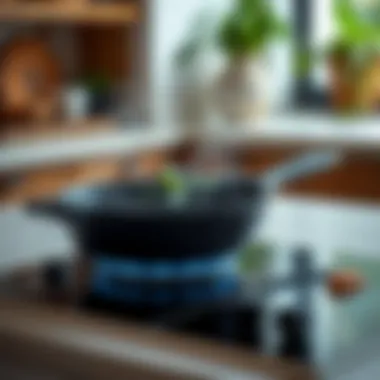
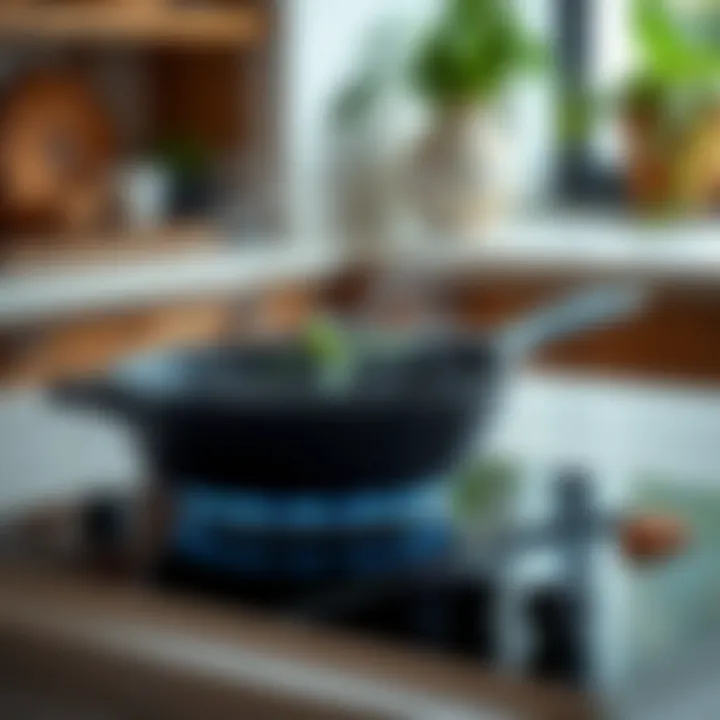
Intro
Electric burners have become a household staple, changing the way many individuals approach cooking. For those who cherish the art of using cast iron skillets, the intersection of these two cooking techniques can seem daunting yet exciting. It’s one thing to hear about electric burners humming away in the kitchen; it’s another to explore how they meld with the robust nature of cast iron cookware.
This article intends to unravel the nuances associated with using electric burners to cook with cast iron skillets. The aim is not simply to discuss how food can be prepared but to delve deeper into the compatibility between these heating elements and the heavy-duty skillets that have been treasured across generations.
Cast iron skillets are renowned for their heat retention and unparalleled cooking capabilities, making them a favorite among food lovers. However, when moving to an electric burner, some might wonder about the overall performance, especially regarding how well these skillets can heat up and maintain temperature under a modern heat source.
Additionally, we’ll explore vital aspects such as safety measures. After all, who wants to encounter a mishap while preparing a sumptuous meal? We’ll provide insights on selecting suitable electric burners that not only complement your skillet but also enhance your culinary experience overall. For example, we will touch on specific brands like Breville and Cuisinart, known for their reliable electric cooking appliances, ensuring you start off with the right tools.
In conjunction with these practical tips, we will address cooking techniques tailored for cast iron and provide maintenance advice that should ideally be part of every cast iron skillet owner’s routine. By the end of this exploration, readers will be equipped with a solid understanding of how to confidently wield their cast iron skillets on electric burners, making them feel like chefs right in their own kitchens.
Electric burners may not have the charm of classic open flames, but if used correctly, they can perform just as well, if not better. Let’s get to work, dive into the world of electric burners, and forge a harmonious bond between science and the art of cooking!
Preamble to Electric Burners and Cast Iron Skillets
In the world of culinary arts, cast iron skillets hold a noble position, revered for their unmatched heat retention and versatility. Yet, as modern cooking evolves, so too does the way we heat our beloved cookware. Enter electric burners—a game-changer for many home cooks and enthusiasts. The compatibility between electric burners and cast iron skillets can open up a realm of possibilities in the kitchen.
The significance of blending these two elements lies not only in the ease of cooking but also in the potential to elevate flavors and textures. Electric burners come in multiple forms, each presenting distinct features that could either complement or challenge cast iron cooking. Understanding their interplay ensures that cooks, from novices to seasoned chefs, can harness the full power of their skillet without hitting roadblocks.
Understanding Cast Iron Cookware
Cast iron skillets are often referred to as "kitchen workhorses". They are durable, heat-efficient, and capable of developing a natural non-stick surface when adequately cared for. Cast iron is unique in that it gains seasoning through use; the more you cook with it, the better it performs. However, these skillets require special attention when used with various heat sources.
Cooks must consider the specific properties of cast iron when pairing it with electric burners. For example, the weight of the skillet needs to be supported effectively, especially on smaller burner models. Additionally, because cast iron takes time to heat up and cool down, the burner’s heat control plays a pivotal role in achieving that perfect sear or fry.
Overview of Electric Burners
Electric burners have come a long way from their early iterations. Now, they come in various types, including coil burners, glass-top radiant burners, and induction cooktops. Each type has its quirks that affect how cast iron skillets respond.
- Coil Burners: These are the traditional burners, uncomplicated and effective. They take longer to heat up, but once they do, they provide steady heat, though the uneven surface could cause hot spots.
- Glass-Top Burners: These offer a sleek appearance and are easy to clean. However, they usually distribute heat unevenly. Cookware needs to have a flat bottom for optimal contact.
- Induction Cooktops: This modern marvel uses magnetic fields to directly heat the skillet. It provides precise temperature control but requires cast iron that is induction-compatible.
The choice of electric burner can significantly affect the cooking experience. Do note that the thickness and material of the skillet must align with the burner’s capabilities to ensure a successful cooking adventure.
Understanding these basics lays a solid groundwork for cooks looking to maximize their electric cooking experience with cast iron skillets. Whether aiming for that golden-brown crust or simmering a comforting dish, recognizing the strengths and limitations of both is essential.
"The art of cooking is not just about the ingredients; it’s about how you combine the tools with what you have"
As we explore further, the journey into the compatibility and efficiency of electric burners with cast iron skillets continues.
Compatibility of Electric Burners with Cast Iron Skillets
When it comes to using electric burners with cast iron skillets, compatibility is a key factor that can shape the cooking experience. Not all electric burners are created equal, and understanding how different elements of compatibility influence performance is crucial. For home cooks and culinary enthusiasts alike, having the right information helps maximize efficiency and prevents unnecessary frustrations in the kitchen. Factors like shape, size, and heat distribution can make or break the success of your meal.
Size and Shape Considerations
Choosing the right size electric burner for your cast iron skillet can directly impact the quality of your cooking. Cast iron skillets come in various sizes – from those small enough to hold a couple of eggs to large versions that can accommodate an entire roast. Therefore, it’s vital to match the skillet’s dimensions with the burner’s heating surface.
- A skillet that is much larger than the burner may not heat properly, resulting in uneven cooking. Imagine whipping up a beautiful frittata only to find the edges cooked while the center remains uncooked due to inadequate heat coverage.
- Conversely, using a very small skillet on a larger burner could lead to overheating of the skillet's sides, which might create hot spots that burn food before it cooks through.
In terms of shape, round skillets generally fit well on round burners, but if your skillet has uneven or angled edges, you may need to consider how it will balance on flat surfaces. For example, certain models of electric burners, like the NuWave Induction Cooktop, offer a larger area designed specifically for accommodating various pot shapes. This could be beneficial for those trying to utilize a more versatile range of cooking techniques.
Heat Distribution Dynamics
The heat distribution of an electric burner has a significant impact on how effectively a cast iron skillet cooks. Cast iron is celebrated for its heat retention but can also have challenges when paired with certain types of electric burners. Here’s what to keep in mind regarding heat dynamics:
- Induction Burners: These burners heat the skillet directly through electromagnetic induction. They provide rapid adjustments to temperature, which is excellent for dishes requiring a quick temperature change. However, the skillet's base must be flat for optimal contact to achieve even distribution.
- Coil Burners: More common in traditional electric stovetops, these burners can result in slower heating. While they may distribute heat adequately for longer cooking periods, they often lack the precision needed for high-heat techniques such as searing.
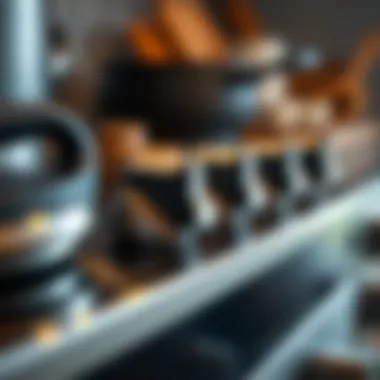
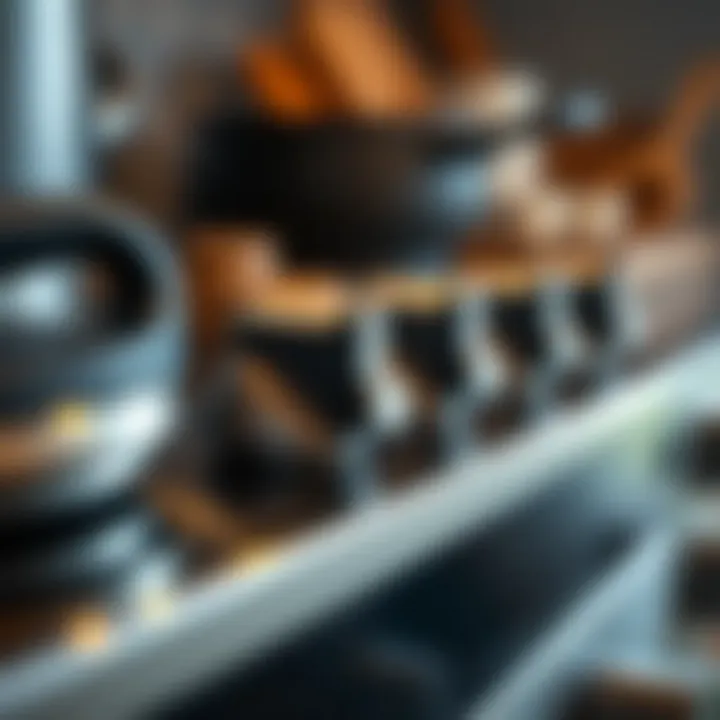
Using an electric burner with poor heat distribution can lead to a situation where the center of your skillet is excessively hot, while the edges barely reach cooking temperature. A quick stir might not help here, especially when trying to achieve a perfect crust on a skillet pizza.
"The right tools make all the difference in the kitchen; blending heat and cookware compatibility leads to culinary triumphs."
Useful Resources:
- Wikipedia on Cast Iron Cookware
- Britannica article on Cookware
- Reddit discussions on Electric Skillet burners
- Cooking safety tips on .gov sites
Thus, investing in compatible tools ensures that your culinary efforts blossom, making every dish a crowning glory.
Types of Electric Burners Suitable for Cast Iron
When it comes to cooking with cast iron skillets, the type of electric burner you choose makes a world of difference. Using electric burners not only affects the cooking efficiency but also impacts the safety and ease of handling the skillets. Understanding the nuances between various types of electric burners can help you make an informed decision, ensuring that your cast iron skillets perform at their best while delivering delicious dishes.
Single vs. Double Burners
In kitchens where space is often at a premium, the decision between a single and double electric burner becomes pivotal. Single burners are compact and ideal for small cooking tasks or if you’re only using one skillet at a time. They are portable, easy to stow away, and can sometimes be less expensive. Imagine making a simple breakfast—pancakes on your trusty cast iron skillet—on a single burner. However, this comes with limitations, particularly when you want to multitask.
On the flip side, double burners offer versatility and allow you to cook multiple dishes simultaneously. If you want to sauté vegetables in one skillet while frying meat in another, a double burner provides the surface area and heating power you need. When selecting between the two, consider your cooking style. Do you often whip up elaborate meals? A double burner might just be worth its weight in gold.
Cooking on a double burner is like having your cake and eating it too. You can stir-fry on one side while simmering a sauce on the other.
Induction vs. Coil Burners
The choice between induction burners and coil burners is another key consideration. Induction burners are known for their rapid heating capabilities and precise temperature control. They use electromagnetic energy to create heat directly in the cookware. This makes them incredibly efficient; as soon as you place your cast iron skillet on, the heat is instant, and you have fine control over the cooking process. For those who are serious about cooking, induction is a game changer.
However, it's crucial to note that not all cast iron skillets are compatible with induction cooktops. You’ll need to ensure your skillet is magnetic; if a magnet sticks to the bottom, you’re good to go.
On the other hand, coil burners rely on heating elements visible on the surface, which can take longer to heat up and cool down. They are generally more affordable and compatible with any cast iron cookware. Although they might not heat as evenly, they can still perform adequately depending on your cooking needs. If you're aiming for good searing and frying, coil burners can deliver those results quite well, provided you manage the heat settings properly.
Advantages of Using Electric Burners with Cast Iron Skillets
In the realm of culinary pursuits, the fusion of technology and traditional cooking methods presents unique advantages, particularly when using cast iron skillets on electric burners. This segment explores how electric burners enhance the cooking experience, proving to be effective partners for cast iron skillets. The consistency in performance, safety features, and versatility modern electric burners offer makes them indispensable tools in any kitchen.
Precise Temperature Control
One of the standout features of electric burners is their ability to provide precise temperature control. This precision is crucial when it comes to cooking with cast iron, as achieving the right temperature can mean the difference between perfectly seared steaks and over-done, chewy morsels. Electric burners allow for careful adjustments in heat levels, which is especially useful for techniques such as frying or slow-cooking.
When you crank up the temperature, say, to sear meats, or dial it down for a gentle simmer, the electronic controls respond immediately. This capability means cooks can confidently know when their skillets are ready. The visual cues from the burner's settings combined with the skillets’ heat retention properties creates a harmonious cooking environment.
"Consistency is key when it comes to cooking, especially with cast iron. Electric burners deliver that consistency, ensuring results that keep you coming back for more."
Ease of Use and Convenience
Cooking can often feel like a juggling act, and that's where electric burners come into play with their user-friendly design. Unlike traditional stovetops, electric burners eliminate the need for flame management, allowing cooks to focus more on the food and less on the heat source.
Imagine a crowded kitchen where every minute counts. Electric burners heat up without any fuss, making meal prep smoother. The flat surface design accommodates various skillet sizes, removing any guesswork about fitting your heavy cast iron. This convenience is a game changer, particularly when trying to whip up something quick after a long day.
Additionally, many electric burners have built-in safety features, such as auto shut-off, which can provide peace of mind, especially for those who might be a bit distracted while cooking.
The convenience extends beyond just operation; it also makes for simpler clean-up compared to traditional stoves, where food splatter can create a mess. Electric burners typically have smooth surfaces that are easier to wipe down.
To sum up, the electric burner-cast iron skillet duo presents a cooking experience filled with control and ease, matching technology with culinary tradition in a way that empowers cooks of all levels.
Challenges of Electric Burners for Cast Iron Cooking
When it comes to cooking with cast iron skillets on electric burners, certain complexities can arise. Understanding these challenges is crucial for anyone looking to make the most of their culinary tools. While electric burners provide a clean and convenient cooking option, there are limitations that need addressing.
Heating Limitations
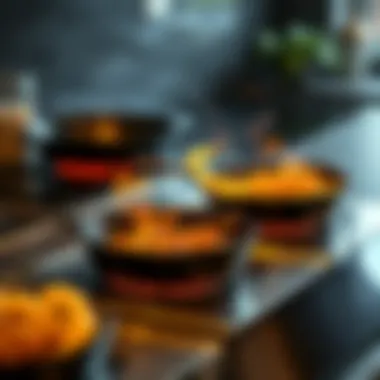
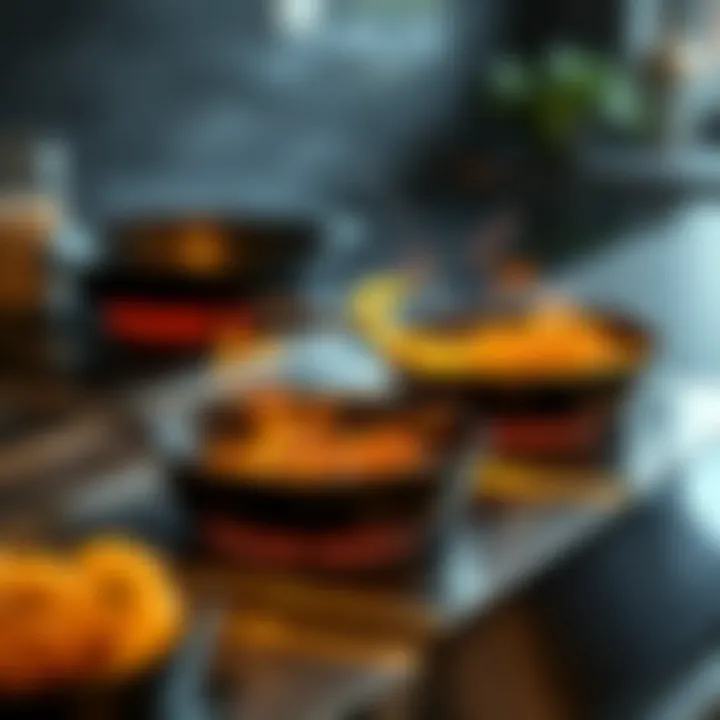
One of the primary concerns with electric burners is their heating limitations. Unlike traditional gas stoves that offer instant heat control, electric burners tend to take longer to reach full temperature. For cast iron enthusiasts, this can pose a problem. Cast iron requires adequate preheating to create a nice sear on meats or to achieve the right frying temperature.
- Slow Response Time: Electric burners often have a delayed response to temperature adjustments. If you turn the dial down on a high setting, it might take longer than you expect for the skillet to cool down. This can lead to overcooked food if not monitored closely.
- Heat Consistency: Some electric burners may not distribute heat evenly. This can make it challenging to maintain a stable cooking temperature. For instance, say you’re trying to simmer a sauce in your cast iron skillet; having uneven heat could lead to burning in certain spots while other areas remain cool. Therefore, it’s essential to select a burner that evenly distributes heat.
"The beauty of cast iron is in its retention of heat. However, static heating from electric sources can cause dips in performance."
Potential for Uneven Cooking
Another misconception about using electric burners is the potential for uneven cooking. The very nature of how electric burners operate means they can create hot and cold spots, which is not ideal for cast iron cooking.
- Surface Area Disparity: If the electric burner’s coil or induction plate doesn’t match well with the base of your skillet, you may not get an even heat spread. Effectively, various parts of the skillet can reach different temperatures, leading to inconsistent cooking results.
- Food Sticking: Uneven heat can result in food unevenly cooking, with some sections getting more heat, causing food to stick more on those hotter spots. This can be detrimental to dishes that require precise temperature control, like frying eggs or delicate pancakes.
In summary, while electric burners can be a convenient substitute for traditional cooking methods, they do come with their own set of challenges. Lives can be made easier with the right knowledge, providing you can navigate through the heating limitations and potential for uneven heat. Understanding these difficulties enables cooks to hone their skills with electric burners and cast iron skillets, ensuring that an enjoyable cooking experience is maintained.
Best Practices for Cooking with Electric Burners
Cooking with electric burners can be somewhat tricky, especially when you’re using heavy-duty cast iron skillets. To get the best out of your culinary experience, adopting best practices can make a world of difference. It’s about more than just heating your skillet; it’s a dance of timing, technique, and care. Following these simple yet effective guidelines will ensure your meals turn out just right while preserving the integrity of both your skillet and the burners themselves.
Preheating the Skillet
Before diving into your recipes, preheating your cast iron skillet on an electric burner is crucial. This practice allows for even heat distribution, essential for avoiding hot spots that can lead to uneven cooking. When you preheat, the surface of the skillet achieves that perfect sear, locking in moisture and flavor.
Warming the skillet gradually, instead of cranking up the heat to high, will lead to better results. A common approach is to set your electric burner to medium or low for several minutes of preheating. You can sprinkle a few drops of water onto the skillet; if they dance around and evaporate, you're ready to start cooking. Remember, patience pays off.
Using Suitable Cooking Techniques
Cooking with electric burners might require some technique tweaks compared to traditional gas stoves. Here are two primary methods that work wonders with cast iron:
Searing and Frying
Searing and frying are superb techniques for showcasing the versatility of your cast iron skillet. This method often brings out rich flavors and creates a beautiful crust on meats and vegetables. The key characteristic of searing is achieving a high temperature in the skillet to caramelize the surface of the food.
Why is this beneficial? The intense heat creates a Maillard reaction, which adds depth to your dishes. It’s a popular choice in many kitchens because it elevates simple ingredients into something magical. Use a little oil with a high smoke point, like canola or grapeseed oil, to avoid burning and achieving that golden brown color without the smoke.
One downside is that if the burner does not distribute heat evenly, you might find one side of your food cooks faster, which can be a bit of a bother. Keeping an eye on the cooking process and adjusting the positioning can help remedy this.
Slow Cooking
Slow cooking is another fantastic technique when it comes to cast iron skillets. It allows flavors to meld beautifully while tenderizing tougher cuts of meat. The beauty of slow cooking is that it requires less attention compared to fast cooking methods. Set your electric burner on low, cover the skillet, and let time work its magic.
This method is particularly beneficial for soups, stews, and casseroles, crafting rich flavors over time. The unique feature of slow cooking is how it allows the food to absorb the seasonings and juices without losing moisture. You can prepare a meal in the morning and let it simmer gently throughout the day, returning to a delightful dish.
However, it’s important to note that slow cooking won’t provide that satisfying crust that some recipes demand, which means it works best for certain types of meals rather than others.
By following these practices in preheating and using suitable cooking techniques, you maximize your experience with electric burners in tandem with your cast iron skillet. Keep these considerations in mind, and you're set to create amazing dishes!
Maintaining Electric Burners and Cast Iron Skillets
Keeping your electric burners and cast iron skillets in top-notch condition ensures both safety and performance. A well-maintained setup improves your cooking experience and extends the life of your equipment. It's easy to overlook maintenance, but neglecting either can lead to subpar results in the kitchen. This section dives into best practices for maintaining both your burners and skillets, which can make a world of difference in your culinary endeavors.
Cleaning and Care of Burners
Regular cleaning is just as crucial for electric burners as it is for any cooking apparatus. These burners often accumulate grease, food residues, and spills that can affect their efficiency.
- Wipe Down After Use: It's best to clean the burners soon after they've cooled down but while they're still slightly warm. This helps lift the grime with ease.
- Use Appropriate Cleaners: Avoid harsh chemicals. Instead, a mixture of baking soda and water can be a good bet; it’s gentle yet effective.
- Inspect Connections: Pay attention to the electrical connections. Any signs of wear could lead to electrical issues, making it unsafe for use.
Tip: Always refer to the manufacturer’s recommendations for specific cleaning instructions. This ensures you don’t inadvertently void any warranty by using improper methods.
Seasoning and Storing Cast Iron
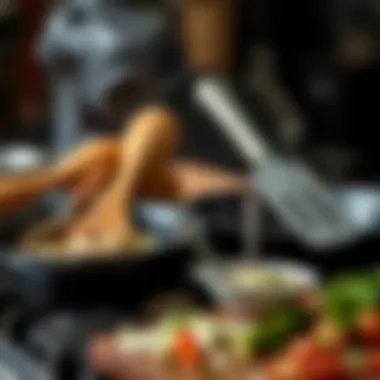
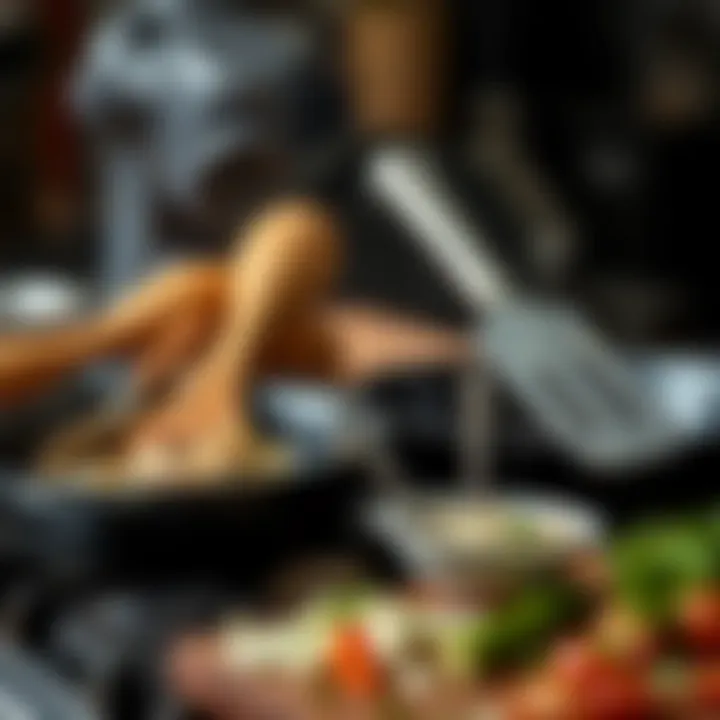
A cast iron skillet is only as good as its seasoning. Proper seasoning not only enhances the skillet's non-stick qualities but also protects it from rust. Here are some pointers for effective seasoning and storing:
- Initial Seasoning: If your skillet is new, initial seasoning is key. Clean it thoroughly, then apply a thin layer of cooking oil and bake it upside down in the oven for an hour at about 375°F. This will create a nice base layer.
- Ongoing Maintenance: After cooking, clean the skillet with hot water and a stiff brush. Avoid soap, as it can strip the seasoning. Lightly oil the skillet after drying to keep it in shape.
- Storing Properly: Store your skillet in a dry place. Avoid stacking other cookware inside it, as this can scratch the seasoning. Instead, place a paper towel between your skillet and any other item to catch moisture.
"A little care goes a long way in preserving the integrity and performance of your beloved cast iron cookware."
User Reviews and Experiences
User reviews and experiences form an illuminating aspect of understanding how electric burners interact with cast iron skillets. These shared narratives draw from real-life kitchen adventures, showcasing both triumphs and challenges, which serve to inform and educate others. They provide helpful insights beyond mere technical specifications or features but rather focus on practical usage in day-to-day cooking.
Success Stories
Many home cooks have taken to electric burners with their trusted cast iron skillets and emerged with impressive anecdotes. One such story comes from Maria, a self-taught chef who found that using an induction electric burner transformed her cooking game. "When I cooked my family’s famous chili in my cast iron, the even heating of the induction burner was a game changer. It helped the flavors meld without scorching the bottom, which happened too often with my old coil burner."
Similarly, Jack, who swears by electric burners for their precision, shares, "I was skeptical at first, but using a double burner with my large skillet allowed me to sear meat evenly. Plus, clean-up is much easier compared to a gas stovetop. The control is just fantastic!" These stories demonstrate not only satisfaction with cooking results but also the convenience electric burners can offer.
Common Complaints
Yet, not all feedback has been glowing. Common complaints often arise from those less than thrilled with their experiences. Ana shared her frustration after purchasing a cheap electric burner, stating, "I thought I could save a few bucks, but the uneven heat distribution made my cornbread a disaster!" This points to the critical consideration of burner quality when working with cast iron.
Moreover, users often cite that cooking times can vary significantly from traditional methods, causing confusion. Tom remarked, "I had to adjust my cooking times by quite a bit since the heat settings don’t translate directly from my gas stove. It took some getting used to."
In particular, some cooks note issues with a lack of responsiveness, with electric burners taking longer to adjust temperature compared to gas. These narratives underscore the importance of selecting the right equipment and adapting techniques to get the most out of using electric burners with cast iron cookware.
"It's always a learning curve when switching up your cooking methods, but the journey can yield delicious rewards."
User reviews provide essential feedback for prospective buyers, helping them make informed decisions on which electric burners may pair best with their beloved cast iron skillets.
Future Trends in Electric Cooking Technology
The world of cooking is ever-evolving, especially when we consider electric burners and their compatibility with cast iron skillets. Embracing these advancements can significantly enhance cooking experiences, paving the way for innovation in home kitchens. As chefs and home cooks alike contemplate their cooking options, understanding the trends in electric cooking technology is pivotal. This section aims to highlight emerging technologies that promise benefits in performance, energy efficiency, and user experience.
Innovations in Burner Design
The landscape of electric burners is undergoing a revolution, with innovative designs emerging to cater to the specific needs of cooks using cast iron. Among the most exciting innovations are:
- Smart Burners: Integration of smart technology is making cooking more intuitive. Burners that can connect to smartphone apps allow users to monitor temperatures and cooking times remotely, ensuring precise control.
- Flexible Heating Zones: New designs enable users to adjust the size of the heating element, accommodating various sizes of cast iron skillets. This versatility leads to greater efficiency, allowing for better energy usage.
- Rapid Heating Features: Burners with advanced heating technologies, like induction, offer quicker heat-up times than conventional coil burners. This is particularly advantageous when searing meats or preheating skillets, reducing waiting times significantly.
These advancements not only improve safety with features like automatic shut-off but also make it easier for users to achieve the exact results they desire while cooking with cast iron.
Potential Developments for Cast Iron Cookware
As the electric cooking technology develops, so too does the potential for innovations in cast iron cookware itself. Expectations for the future include:
- Weight Reduction: Efforts to create lighter cast iron alternatives could make these skillets easier to handle without compromising their heat retention properties.
- Non-Toxic Coatings: Advances in coatings that can withstand high heats without leaching harmful chemicals are on the horizon, promoting healthier cooking practices.
- Enhanced Heat Distribution: Future designs may focus on improved heat distribution, ensuring even cooking across the entire skillet surface. This would greatly enhance the culinary outcome and gives rise to a more consistent cooking experience.
The marriage of cutting-edge electric cooking technology with cast iron's enduring charm promises to redefine culinary standards, allowing home cooks to harness the full potential of their kitchen.
In summary, these trends in electric cooking technology point toward a future where the synergy between electric burners and cast iron skillets is harmonized. This evolution promises not just convenience but safety, efficiency, and an overall enhanced cooking experience for food enthusiasts at all levels. As we look ahead, it’s clear that integrating modern technology into traditional cooking methods offers a pathway to culinary mastery like never before.
Closure
As we draw the curtain on this exploration of electric burners and cast iron skillets, it’s essential to reflect on the key threads woven throughout the topic. This journey highlights not just the compatibility of these two cooking elements but also their collective potential to elevate one’s culinary experience.
In the course of this discussion, we investigated various facets such as design compatibility, heating efficiency, and the nuances of cooking techniques suitable for cast iron. Each aspect underscores the significant impact electric burners can have when paired correctly with cast iron skillets. The principle takeaway here is that when you choose the right burner, you unlock the full potential of your skillet.
Considering the attributes of both electric burners and cast iron skillets lays the groundwork for improved performance in the kitchen. While cooking with cast iron is steeped in tradition, the transition to electric heating opens up a realm of possibilities. It allows for precise temperature control and the convenience of modern cooking, which can be pivotal for both novices and seasoned chefs alike.
A few specific points merit reiteration:
- Uniform heat distribution can enhance the overall cooking experience, facilitating thorough cooking while safeguarding against the dreaded burnt patches.
- Ease of maintenance with electric burners complements the natural durability of cast iron, making cleanup less of a chore.
- Adaptability in cooking methods presents a marvelous opportunity to experiment, allowing for everything from high-heat searing to gentle simmering.
However, it’s also crucial to acknowledge some limitations that come with electric use, like possible longer heating times or challenges associated with uneven cooking. Being aware of these elements mold a more prepared cook.
Ultimately, the compatibility of electric burners with cast iron skillets is not just a practical concern but a pathway towards unlocking richer flavors and textures in every dish. As the culinary landscape evolves, blending traditional methods with innovative approaches may well be the secret ingredient that enhances your cooking journey.







